IDC: Q1 Storage Sales Shows Huge Shift From Enterprise To Cloud

The Shifting Focus Of Storage
The storage market appears to be making a big shift away from traditional enterprise storage vendors to the hyper-scale data center companies, according to the first quarter edition of IDC's 2017 Worldwide Quarterly Enterprise Storage Systems Tracker.
Framingham, Mass.-based analyst firm IDC said total worldwide enterprise storage revenue in the first quarter was $9.2 billion, down slightly from the first quarter of 2016 despite a massive 41.4 percent increase in capacity shipped over the past year.
Three of the top five storage vendors – Dell EMC, HPE, and Hitachi – saw significant drops in their storage revenue in the first quarter compared to last year, while NetApp saw a huge jump and IBM grew a bit, according to IDC.
But the biggest change was a nearly 80 percent jump in the amount of storage that went to what IBM calls ODM direct, which primarily includes hyper-scale data center companies including the top public cloud vendors and cloud-based application providers, showing a solid shift in the way businesses and consumers consume storage capacity.
For a look at what happened during the first quarter of 2017, keep reading.

First, The Good News: Flash Storage Sales Soar
The ray of hope for storage vendors is the booming sales of flash storage systems, which are growing as customers accept the higher performance and lower power consumption and footprint of flash storage versus that of disk-based storage.
IDC said the total all-flash storage array market grew 75.7 percent in the first quarter of 2017, over the same period last year, to reach almost $1.4 billion in revenue. All-flash storage accounted for 15.2 percent of the total enterprise storage market.
Sales of hybrid flash storage arrays also did well, reaching $2.0 billion in revenue and accounting for 22.0 percent of the total market, IDC said.
Total Enterprise Storage Sales Flat
IDC breaks the enterprise storage business into two categories. The first is worldwide total enterprise storage systems, which includes sales of all enterprises storage whether internal to a server or external in a storage area network.
Total enterprise storage systems revenue fell 0.5 percent over last year to $9.2 billion, or essentially flat. However, this came despite a massive 41.4 percent growth in the total capacity to 50.1 exabytes, reflecting a huge drop in the cost of storage, per terabyte shipped.
This was a tough quarter for many enterprise storage vendors, particularly Dell EMC, Hewlett Packard Enterprise and Hitachi, which saw significant year-over year drops in sales. NetApp, however, is experiencing serious growth.
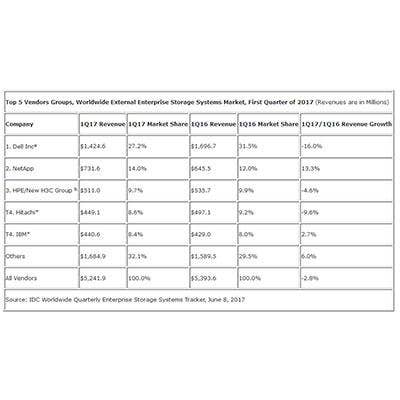
Big Drop In Worldwide External Enterprise Storage Systems Sales
The second category, external enterprise storage systems, focuses on sales of storage in stand-alone systems outside the server.
Here, IDC reported a 2.8 percent drop in total worldwide revenue to $5.2 billion. The decline in sales here was significantly higher, as a percentage, than the drop in total enterprise storage systems because the storage capacity used by hyper-scale data centers typically is inside their servers.
Again, it was Dell EMC, HPE and Hitachi/HDS that saw sales drops, while NetApp and IBM enjoyed a growth in sales. Also interesting was the 6 percent increase in sales by the "others" category, which includes custom-built storage, OEM, and smaller vendors.

IDC's Explanation
"The enterprise storage market closed out the first quarter relatively flat, yet adhered to a familiar pattern," explained Liz Conner, Research Manager, Storage Systems, IDC.
"Spending on traditional external arrays continues to slowly shrink while spending on all-flash deployments once again posted strong growth and helped to drive the overall market. Meanwhile the very nature of the hyperscale business leads to heavy fluctuations within the market segment, displaying solid growth in 1Q17," Conner said.

ODM Direct Business Takes Over Big
IDC reported that total enterprise storage systems sales via ODM direct rose 78.2 percent to $1.2 billion. This category, which includes ODM storage vendors selling directly to hyper-scale data centers, accounted for 13.2 percent of global spending during the quarter, IDC said.
ODM direct sales to hyper-scale data centers was not a significant part of the external enterprise storage systems market given that hyper-scale data centers are more likely to purchase storage that is deployed inside the massive number of servers they purchase.
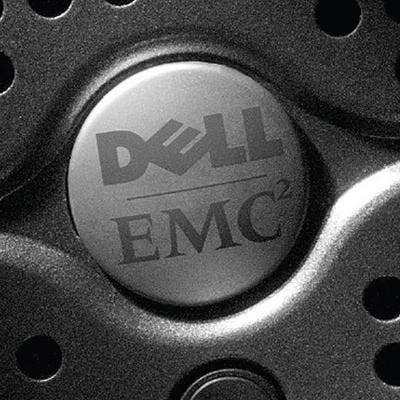
Dell EMC Is Still No. 1, But …
Dell EMC is still the largest storage vendor despite a huge drop in first quarter 2017 storage sales.
IDC reported Dell EMC's total enterprise storage system sales in the first quarter at $2 billion, down 14.6 percent over its first quarter 2016 sales, which still gave it a 21.5 percent market share. Dell EMC's worldwide external enterprise storage systems sales dropped 16 percent to $1.4 billion, which was still 27.2 percent of the market.
Dell EMC, in an unattributed statement emailed to CRN, said the company is optimistic given recent customer engagements and its recent product refresh.
"In light of Dell EMC’s move to a new fiscal reporting calendar that has skewed IDC’s reported numbers for our storage business, coupled with IDC’s reported 2.8% decrease in the overall market for Q1, the dip in Dell EMC’s calendar Q1’17 market share was anticipated. We expect IDC’s numbers will normalize in future quarterly market share reports," the company wrote.
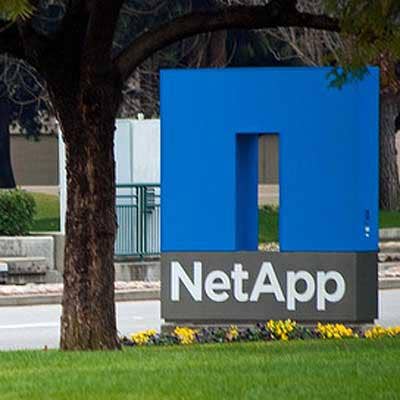
NetApp: Sort Of No. 2
Of the top storage vendors, NetApp was the big winner by a huge margin in the first quarter of 2017.
NetApp maintained its position as the second-largest storage external storage systems vendor, with sales of $731.6 million, up 13.3 percent over last year. And because NetApp does not sell servers, its total worldwide enterprise storage systems was also $731.6 million, which gave it a respectable third place in that category.
NetApp has been gaining strength for several quarters as it has sorted out issues related to transitioning customers to its latest Ontap operating system. Even more significant, NetApp appears to be the fastest-growing flash storage vendor, and could grab the No. 1 spot in that part of the market soon.
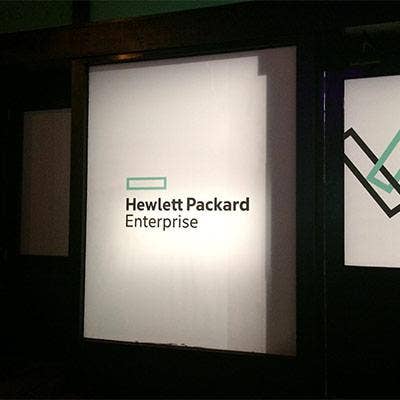
HPE: Sort Of No. 2
HPE retained its position as the second-largest total enterprise storage systems vendor with first quarter 2017 sales of $1.9 billion, which was down 18.6 percent year-over-year. The company's external enterprise storage system business, led by its HPE 3Par storage line, did much better, with sales of $511.0 billion, down only 4.6 percent over last year, IDC reported.
HPE late last month reported total sales of its Enterprise Group fell 13 percent year-over-year to $6.2 billion, which it attributed in part to the loss of a significant unnamed customer. The one bit of good news for the quarter was a 33 percent growth in HPE's all-flash storage sales, HPE reported.
HPE sales include those attributed to China-based New H3C Group, which has a joint venture with HPE.
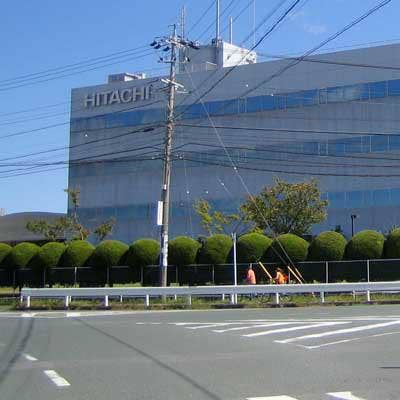
Hitachi/HDS #4
Hitachi and its subsidiary Hitachi Data Systems saw total enterprise storage systems sales drop 9.4 percent to $460.1 million in the first quarter compared to last year. For external enterprise storage systems, sales fell 9.6 percent to $449.1 million, IDC reported.
Hitachi and HDS are gradually moving their focus towards newer data center applications including IoT and the cloud, although the company said that shift does not mean it is less focused on storage.
Bob Madaio, vice president of infrastructure solutions marketing at HDS, told CRN via email not to expect large storage revenue industry increases over time. "Enterprise storage systems remain critical to managing the data of our customers' most critical applications, and we believe our history of reliability and performance will continue to keep us in the shortlist of customers across industries who need the best possible storage and data services to power their digital transformation," Madaio wrote.
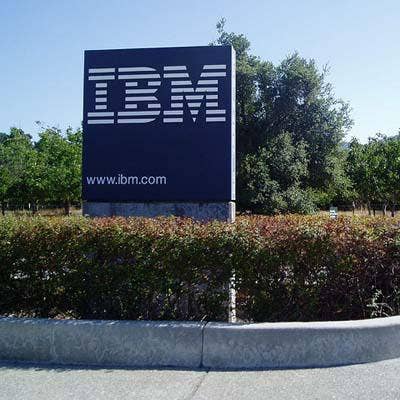
IBM At No. 5, And Actually Growing
IBM is the only other vendor besides NetApp to show enterprise growth in the first quarter of 2017, according to IDC.
The vast majority of IBM's storage sales are external after the company sold its x86-based server business to Lenovo. IBM total enterprise storage system revenue for the first quarter rose 1.5 percent to $455.3 million, largely on the strength of its flash storage sales. For external storage systems, IBM's revenue grew 2.7 percent to reach $440.6 million.
Eric Herzog, vice president of product marketing and management for IBM storage systems and software defined infrastructure, told CRN via email the company's growth stems from strength in strategic areas such as flash and software-defined storage. "We expect to build on our momentum as we enter a new period of innovation and growth in storage infrastructure," Herzog wrote.